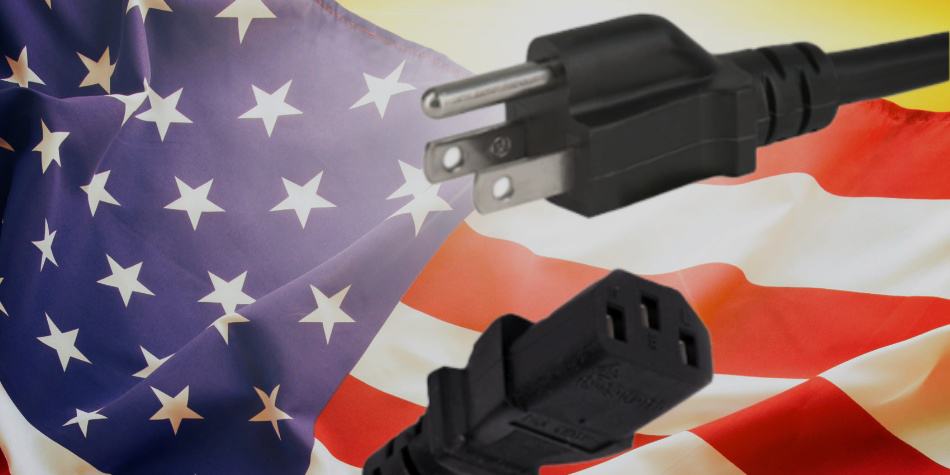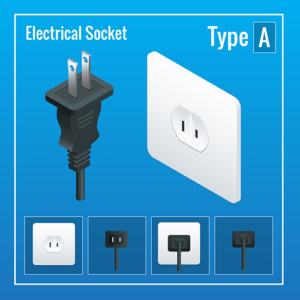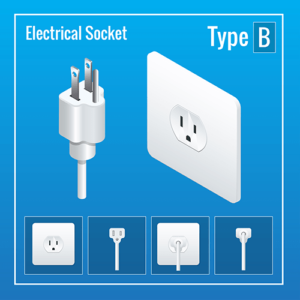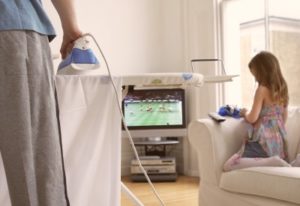Is it worth shipping UK electrical items to the US? And how do you adapt UK electronic goods for the US electric system? We provide all the answers…
If you are moving from the UK to the US, you need to understand the differences in the electrical system so you can plan your move well.
Moving from the UK to the USA can be an exciting time. Yet, it can also be stressful as you arrange flights, pack boxes and say your goodbyes. Another task on your to-do list is to decide which electrical goods to bring with you, and which to sell or give to friends and family.
Will electrical goods work in the USA from the UK? The best way of answering this question is to understand the differences between the UK and US electrical systems. The North American electrical system differs from Europe and other areas of the world significantly, making it a priority for you to be aware of the differences before leaving the UK.
Unlike Moving to Australia or New Zealand where electrical appliances can be expensive to replace, the USA has many stores such as Walmart where you can pick up inexpensive electrical replacements and therefore it is easier just to buy new when you arrive. However, if your electrical items can be easily adapted, you’ll want to bring them with you.
Can You Use UK electronics in the United States?
Some UK electrical items can be used in the US, but as the UK voltages differs compared to the United States, others can’t or will need significant adaptation. The standard UK voltage is 240v, whereas the United States standard voltage is 120v. Devices that are dual-voltage work between 110v to 240v, making them suitable for both the UK and the United States. However, many larger appliances or those involving a heating element may not be suitable for use in the United States. This article will explain in more detail.
What Are the Differences Between the UK and US Electrical System?
The differences between the electrical systems in the UK and the US system can be split into three different areas.
-
Voltage
As we previously mentioned, the main difference is the voltage of the systems. In the UK, the standard voltage used is 240V, while in the USA, their system uses 120V. This difference is crucial because electrical products are designed to work at different voltages. For example, a UK device may operate at 230V and be suitable for the UK system but not for the USA. Similarly, A USA-made device could operate at 110V and not be suitable for the UK. Some devices have dual voltage and work between 110-240V.
-
Frequency
Another difference between the systems is in their frequency. In electrical systems, the frequency is measured in Hertz (Hz) and refers to the number of times that a sine wave travels around a positive-negative cycle in one second. Most international frequencies are either 50Hz or 60Hz. It just so happens that the UK has the former rating and the USA has the latter.
-
Type A and Type B Plugs
The other main difference between the two systems is seen in the electrical plugs used. In the UK, we use a Type G plug which has three pins. In the USA, they use two different types of plugs, Type A and Type B.
One more interesting difference between UK and US outlets is the direction of the switch. Here in the UK, we push the switch down to turn the appliance on and switch up to turn it off. Many US buildings have outlets with the reverse function, i.e. up means on and down means off.
Adapting UK plugs for the US system
Assuming the voltage will work in the United States, it is easy to change plugs to US Type A or B, or alternatively to buy a travel adapter. You can also buy an extension lead adapter allowing a number of UK small appliances to be plugged in at the same time.
Understanding the Importance of Voltage
As you can see, the biggest difference between the two systems is in the voltage. Voltage is essentially the pressure that an electric charge is pushed through a conducting loop. When an electric device is manufactured, it is made to work within a range of voltages. For example, some devices may say “200V-230V” on them and this tells us that the device could only be used in the UK because it requires voltage above the US’s electrical system (120V).
How to check the voltage of your appliances?
To find the voltage requirements of an electrical device, the first step is to look at the device itself. Many manufacturers will label their appliances with the requirements in the same way as the example above. Some other appliances may label them differently, such as laptops. On these devices, you may find the voltage displayed as “Input [Number]V”. Volts will always be referenced with a V. If you cannot see it on the device, consult a handbook or contact the manufacturer.
What would happen if you didn’t convert the voltage?
For UK relocators heading to the US, using a 230V device in an 110V system is likely to cause the appliance to work inefficiently, or it may work for a short time before dying. You can also damage the device permanently by doing this. Either way, not using a converter can be costly and does present some safety concerns. It generally would be a greater safety risk to plug in a low-voltage US appliance in a UK outlet.
So, how do you use UK electrical appliances in the USA?
Just because your current appliances may not fit the North American voltage system does not mean that you have to leave them behind. There are ways that you can convert your UK appliances to fit the US system, using an aptly named voltage converter.
A voltage converter is a small device that can change the voltage – or ‘pressure’ – either up or down. For example, if you own a 230V kitchen appliance and wanted to relocate it with you and use it in the USA’s 110V system, you would need a step-up converter to increase the voltage.
This may sound counterintuitive, but remember, you are converting the voltage from the system and you are not converting the appliance itself. The converter will increase the voltage given to the appliance from 110 volts to the 230 volts the kitchen appliance requires to function safely.
To give perspective, someone moving from the USA to the UK would likely need to use a step-down converter to reduce the voltage of the UK’s system to match their US-made products operating at 110 volts.
Whether you choose to buy a converter for your appliance or choose to buy new when you arrive will depend on the cost of replacing it and the cost of buying a converter.
So, should you ship electrical appliances from UK to USA?
Sometimes it is not worth taking your appliances with you because buying a brand-new US appliance is cheaper, especially when considering the shipping costs involved. However, the decision to take the appliance or leave it behind will depend on the type of appliance it is.
The general rule of thumb is that dual voltage appliances that work in both countries are worth shipping because you will only need an outlet adapter to make them work. Other electrical items are not likely to be worth the trouble and any item with a motor or heating element should not be shipped.
You find out more information on shipping your personal and household belongings to the United States in our US shipping guide.
Will my UK TV work in the USA?
Shipping your UK television to the US will not be worth the trouble and headaches that go with it, unless it is dual voltage. Some modern televisions such as Samsung Multisystem TVs are designed to be used in a number of different countries.
If your TV is not dual voltage, the process of making it work in the US can be complex, expensive and not guaranteed to be successful.
If you are still committed to bringing the TV with you, change your mind if the TV does not have an NTSC tuner; it will only make things even more difficult. The good news is that good TVs can be bought in the US for prices often cheaper than in the UK.
Can I use my UK laptop in the USA?
Laptops have been made to be used around the world, which is why they are often dual voltage appliances. This means you will likely see that their voltage reading is 100-240V and made for both continents. Similarly, you will also see that the frequency of the devices covers both the UK and US systems at 50-60Hz.
In these instances, you will only need a plug adapter or to buy a new US charger for the device when you arrive. Double check to see if your laptop is dual voltage before making a decision, but it shouldn’t be a problem.
Will UK game consoles work in the USA?
Your UK-bought Xbox or PlayStation may also have dual voltage and is therefore worth relocating from the UK to the US with you. You will just need a US outlet adapter to make it work in this case, but may want to have the plug changed by a qualified electrician if you use it frequently. Again, before making a decision check the voltage requirements of your device.
What about small electric Items?
Smaller items are fine if they are dual voltage. However, for small items that require a converter, it is often best to leave them behind and buy inexpensive replacements upon arrival in the US.
This is because the shipping costs combined with the cost of a converter will be more than buying new, not to mention the hassle involved. Any smaller item with a fan or motor such as a hairdryer will most likely not be worth taking.
Using UK to USA Travel Adapters
We recommend that you use a travel adaptor plug that can be purchased cheaply before you go. Make sure you check your devices voltage and that they are compatible with the United States or they can be damaged or broken.
UK to USA extension lead plug
Whilst ideal for short term use, such as going on holiday to the States, travel adapters are not meant for long term use. Although these may be good to get you started, you should think about replacing plugs on items you use regularly and especially those that have a higher power load. But again, remember to check the voltage and it would be best to ask a qualified electrician to help you.
Another solution is to purchase a UK to USA extension plug adapter which has multiple sockets. This is a safe and easy way to convert your UK electrical items and you’ll find it a lot cheaper to purchase a few of these online before you leave the UK.
Using UK to USA converters and transformers
If you have a particular need for larger appliances that use 240v e.g. specialist equipment, it is possible to take them if you use a converter such as a UK 240v to USA 120v Step Down Transformer.
But even if you use these your appliances might not work efficiently, as the UK is 50Hz compared to 60Hz in the US.
We suggest you research this area thoroughly if it is something you wish to consider.
Shipping Batteries from the UK to USA
You may have not given much thought to the batteries you will take to America, but there are strict regulations that you will need to know when shipping batteries internationally. This is because batteries can be a safety risk and be the cause of fires. Sending batteries by air freight and sea freight invoke different rules.
Sending Standard Batteries
NOTE: We recommend removing your batteries from any device before shipping – if they leak in transit, your item will be ruined.
Sending standard lithium batteries such as AA or AAA batteries is not recommended when using sea freight. However, it is not against the law to do so when contained in a device with a hard plastic shell or within hard plastic casing. When transporting these types of batteries by air freight, they must be placed inside their respective device and cannot be packaged in any other material or casing.
Sending Lithium-ion Batteries
Sending lithium-ion batteries is possible in both sea freight and air freight by leaving them in their devices or by placing them in a hard plastic case. However, there is an additional rule when transporting them by air freight in these situations, the lithium-ion battery must have a watt-hours rating of less than 100.
NB: You can also only send a maximum of 4 by air, with a maximum 2 per package.
Sending Batteries inside Power Tools
Sending batteries inside power tools is significantly different from using air freight and using sea freight. In the former, the batteries must be attached to the device and any spares must be packaged in a spare container made of hard plastic.
On the other hand, when sending these batteries by sea freight they must be placed in the same type of packaging but there is no restriction to how many can be placed in each box.
NB: For air freight, no pack can contain more than two batteries and no consignment can contain more than four.
If you require more information about shipping batteries overseas read our blog Guide to Shipping Batteries Overseas.
Avoiding extra fees and charges when shipping
When migrating to the USA, you are of course permitted to bring whatever household appliances and furniture that you wish. As long as you meet the right visa or residency requirements, these items can arrive duty-free, so you do not have to pay any extras on top of your relocation costs.
However, there are some conditions. For example, the items you ship over must have been in your possession for at least one year and you must have the intention of keeping them yourself in your new residence. These rules also apply to electrical items being shipped.
You should speak to your shipping company first to ensure you meet the requirements and have all the correct customs paperwork.
Shipping your electrical items and other household goods to the USA? Let PSS International Removals Help!
PSS International removals have been helping UK residents and US expats returning home move to the states for years. Through this experience and meticulous planning, we are able to offer some of the most competitive international removal prices in the UK.
For household, removals check out our US removals service. For smaller shipments check out our box shipping service.
You can also use our free online cost calculator to get an estimate.
We can assist with your specific situation by moving your belongings from your UK doorstep to your new US home or storage space. We take the stress out of your move by handling or working with you on everything. For a free quote on removals to the USA, do not hesitate to contact our friendly team.
We are here to make your UK-USA move as painless as possible!










